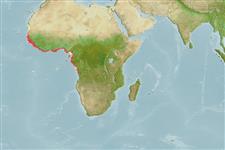Environment: milieu / climate zone / Tiefenbereich / distribution range
Ökologie
seewasser; brackwasser demersal; tiefenbereich 10 - 300 m (Ref. 26999). Tropical; 30°N - 9°S, 18°W - 13°E
Eastern Central Atlantic: Mauritania and the Canary Islands to Angola (9°20'S).
Length at first maturity / Size / Gewicht / Alter
Geschlechtsreife: Lm 34.0 range ? - ? cm
Max length : 60.0 cm TL Männchen/unbestimmt; (Ref. 2683); common length : 45.0 cm TL Männchen/unbestimmt; (Ref. 26999)
Kurzbeschreibung
Bestimmungsschlüssel | Morphologie | Morphometrie
Diagnosis: 10-13, exceptionally 14, transversal scales between the mid-lateral line and the margino-dorsal lateral line (Ref. 81682).
Body shape (shape guide): elongated; Cross section: flattened.
Found on sand and mud bottoms of coastal waters (Ref. 2683).
Menon, A.G.K., 1977. A systematic monograph of the tongue soles of the genus Cynoglossus Hamilton-Buchanan (Pisces: Cynoglossidae). Smithson. Contrib. Zool. (238):1-129. (Ref. 5297)
IUCN Rote Liste Status (Ref. 130435: Version 2025-1)
Bedrohung für Menschen
Harmless
Nutzung durch Menschen
Fischereien: kommerziell
Tools
Zusatzinformationen
Download XML
Internet Quellen
Estimates based on models
Preferred temperature (Ref.
123201): 15.2 - 20.5, mean 17.5 °C (based on 50 cells).
Phylogenetic diversity index (Ref.
82804): PD
50 = 0.5000 [Uniqueness, from 0.5 = low to 2.0 = high].
Bayesian length-weight: a=0.00339 (0.00274 - 0.00419), b=3.10 (3.06 - 3.14), in cm total length, based on LWR estimates for this species (Ref.
93245).
Trophic level (Ref.
69278): 3.6 ±0.4 se; based on size and trophs of closest relatives
Widerstandsfähigkeit (Ref.
120179): mittel, Verdopplung der Population dauert 1,4 - 4,4 Jahre. (K=0.31-0.57; tm=1.5-2).
Fishing Vulnerability (Ref.
59153): Moderate vulnerability (36 of 100).
🛈
Nutrients (Ref.
124155): Calcium = 121 [58, 210] mg/100g; Iron = 0.88 [0.42, 1.45] mg/100g; Protein = 18.3 [16.1, 20.4] %; Omega3 = 0.127 [0.053, 0.282] g/100g; Selenium = 86.5 [44.7, 170.3] μg/100g; VitaminA = 13.8 [5.3, 35.4] μg/100g; Zinc = 1.09 [0.77, 1.52] mg/100g (wet weight);
